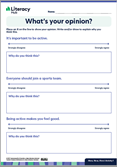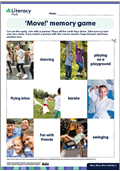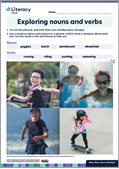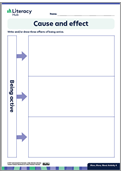Move, Move, Move!
This persuasive book outlines three clear arguments for the benefits of exercise to a person’s health and wellbeing; physical health (improves fitness and heart health), mental health (makes you feel happy), and social benefits (provides opportunities to have fun and make friends).
Back to the shared reading overview page
Text download
Move, Move, Move! as PDF (11.3MB) (opens in new window)
Move, Move, Move! as PowerPoint slideshow (10.1MB) (download)
Printable worksheets
|
|
|
|
|

Teaching & learning sequence
This teaching and learning sequence outlines classroom strategies for Move, Move, Move! including:
- ways to incorporate the ‘Big Six’ core elements of reading development
- fun, engaging and adaptable student activities for a diverse range of abilities
- links to the Australian Curriculum.
| Text features | Cross-curriculum link to the Australian Curriculum |
|
|

First read
As a whole group, enjoy sharing the text and learning together.
Engage
Have the students engage in a quick 5- to 10-minute burst of activity such as a run outside, a dance to some music, some simple exercises or a quick game of chasey.
Initiate a whole-class discussion. How do you feel after that activity? Do you like the feeling of moving, and being active? Do you think moving is good for you? Why?
Read aloud
Show the front cover of Move, Move, Move! Talk about the title and the image. What do you think this book might be about? What might we find out by reading it? Discuss students’ predictions.
Read the book aloud, stopping to answer questions and listen to comments that the students may have. On the final double-page spread (pages 10 and 11) talk about the labelled photographs and the way they have been used to summarise the main arguments.
Read the blurb on the back cover of the book. Explain that it is called a blurb, and discuss its purpose. What is the purpose of a blurb? Why might a book have a blurb? Would reading this blurb make you want to read the whole book? Why? Discuss.
Make meaning
Ask students to turn to a partner and tell each other what they learnt from Move, Move, Move! Have students share their ideas in a class discussion.
Talk with the students about what type of text Move, Move, Move! is. What type of book is this? What is its purpose? Discuss and draw out that it is a persuasive argument aiming to convince people that they should move and be active.
Encourage students to think critically about the text and its message. What is the author’s point of view about being active? What is their message to people who read this book? Does this book persuade you to be active? What did the author KA Nagle do to try to convince you? Discuss students’ opinions. How else could you persuade people about the importance of being active? How could you encourage them to move more?
Revisit the text
Return to the text several times to look more closely at different aspects of its content, structure and language features. This is a great vehicle for exploring the ‘Big Six’ of literacy in an integrated way, with all components linking to the same text.
Comprehension
Reading is about making meaning. Choose from these comprehension activities to help your students explore the text deeply, make personal connections, develop new understandings and draw conclusions. The activities will also help students analyse the text, think critically about it and form their own opinions.
Diversity and inclusion
The text Move, Move, Move! provides an opportunity to discuss diversity and inclusion with your class, particularly if there are members of your school community who have physical disabilities or challenges. You could:
- discuss the concept that people can have different levels of movement
- talk about ways to include everyone in physical activities
- practise ways of positively interacting with others to include them in games.
Why should we move? (whole-group activity)
Discuss: What are the author’s arguments for being active? Use students’ ideas to list arguments on a chart – for example, helps you to stay fit and healthy, makes you feel happy, helps you to have fun and helps you to make new friends. Explain that these reasons can be grouped under the categories of physical health, mental health and being social. On a large chart, model how to record this information as a concept map, for example:
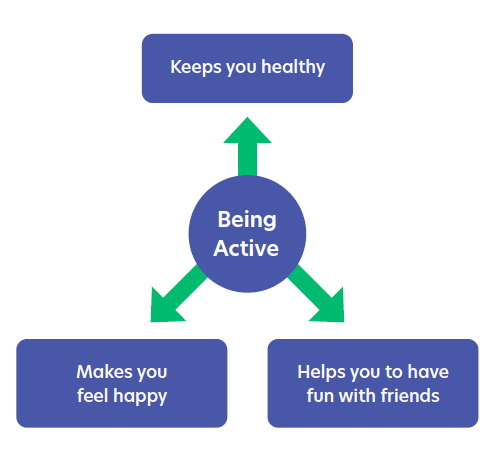
How has the author tried to persuade us that we should move? Discuss and draw out that the author has used a range of things to persuade readers. Revisit the book and point out where and how this has been done. Depending on your students’ level of understanding, focus on some or all of the following persuasive devices used in the book.
- Emphatic statements such as ‘You must move, move, move!’ and ‘Moving is fun!’ Browse through the book and point out where these types of phrases have been used, noting the use of exclamation marks. Why has the author used these types of sentences? What effect does the use of an exclamation mark have?
- Speaking directly to the reader. Point out examples in the book where the author has used the pronoun ‘you’ to address the reader such as ‘Do you like to move?’ and ‘… makes you feel happy!’ Why do you think the author has done this?
- Use of logical arguments such as those on pages 4 and 5. Explain that this is an example of using clear, logical reasons to convince. Is this argument easy to understand? Is it clear? Does it make sense?
- Use of emotive language to create emotions and make you feel a certain way, with phrases such as ‘The more you move the happier you are’ and ‘… being active with your friends is even more fun’. What do you feel when you hear these things?
- Use of images to persuade. Browse through the book and discuss. What do you notice about the photographs? Do they make you want to get active? Why? (See the next activity for more information and ideas.)
Australian Curriculum links
A picture tells a thousand words! (partner activity)
Revisit the text and browse through each page. Encourage students to think about the images in the book and how they support the argument that we should be active. How do the photos in the book make you feel? Do they make you want to be active? Why? How do the images support the author’s message? Why do you think this?
Have students work with a partner to create a poster about one of the three arguments presented in the book. Encourage them to create pictures for their posters that highlight the argument they are presenting.
Have pairs of students share their completed posters with the whole group.
Australian Curriculum links
Brainstorming (whole-group activity)
Brainstorm a list of activities that people can do to be active (for example, dancing, karate, running, hiking, basketball, soccer, skipping). Use students’ ideas to create a semantic word web on a large chart. Encourage students to think beyond the text, and use their own knowledge and experiences to suggest ideas. Your semantic web might look something like this:
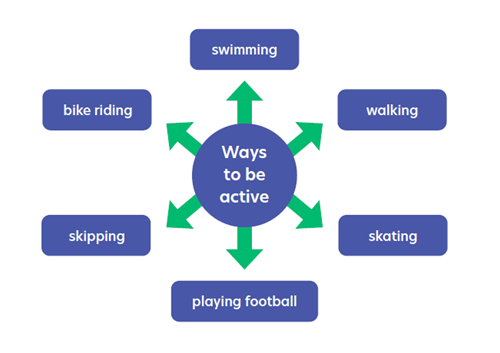
Which of these activities would you like to try, and why? Discuss as a class. Encourage students to use persuasive language to justify why they would like to do the activity.
Australian Curriculum links
Connecting with the text (individual activity)
What things do you do be active? Why do you like doing these things? How do they make you feel? Have students turn and talk with a partner before sharing with the class.
Have students write and/or draw about what they do to be active.
Support students where required by providing them with a sentence starter, for example:

Have students share their finished writing and/or drawings in a small group. Alternatively, you could compile students’ writing and/or drawings to create a class book, and share it with the class.
Australian Curriculum links
Phonological awareness (including phonemic awareness)
These activities will help students to hear the sounds and rhythms of language. Guide them as they explore syllables, onset and rime and listen for phonemes – the smallest units of sound within a word. Use the activities to help your students identify the phonemes in words and practise blending, segmenting and manipulating these sounds.
Blending sounds (whole-group activity)
Use one-syllable words from the text to focus on isolating, segmenting and blending phonemes. For example, talk about the word ‘fit’. What does it mean to be 'fit'? Have students talk with a partner. What sounds can you hear in the word ‘fit’? Have students take turns saying the individual phonemes or sounds that they hear (f-i-t) to a partner. Discuss as a whole class, and have the students join together to blend the sounds and say the word ‘fit’.
Use the word 'fit' to practise manipulating phonemes to make new words. What is the first sound you hear in 'fit'? What would the word say if I replaced the f sound with the b sound? (Repeat with other common initial sounds such as p, h, k and s.)
What is the final sound in the word 'fit'? What other sounds could we put at the end of this word to make new words? Have students talk with a partner about this and then share their new words (fib, fin, fig).
Explore the phonemes in other words from the text such as ‘fun’, ‘play’, ‘park’, ‘bike’ and ‘ride’.
If appropriate for your students, focus on the middle short vowel sounds of CVC words, such as the word 'fun'. Let’s all say the sounds in the word 'fun' – f-u-n. Let’s all say the middle sound – u. What other vowel sound could go in between the f and n sounds to make a new word? (a – fan, i - fin)
Australian Curriculum links
Hearing final sounds (whole-group activity)
Use words from the text to listen for sounds at the end of words. For example, you could use the words:
- ‘fit’, ‘heart’ and ‘must’ to highlight the t sound at the end of a word
- ‘class’, ‘friends’, ‘sends’ and ‘messages’ to highlight the s sound at the end of a word
- ‘karate’, ‘healthy’, ‘body’ and ‘happy’ to highlight the long e sound at the end of a word
- ‘faster’, ‘stronger’ and ‘soccer’ to highlight the schwa vowel at the end of a word.
Say each word from the group slowly and ask students to identify the sound they hear at the end of each word. Have them suggest other words that end in the same sound.
Australian Curriculum links
Hearing sounds in syllables (whole-group activity)
On a chart, write a collection of two-syllable words from the text – such as ‘swimming’, ‘playground’, ‘happy’ and ‘active’.
Investigate each word and have students identify the number of syllables in each word. Ask students to listen for the vowel sound in each syllable. For example, the word ‘swimming’ has the i sound in both syllables, the word ‘playground’ has the long a vowel sound in the first syllable and the ow vowel sound in the second.
Australian Curriculum links
Phonics
Evidence shows that children learn best about the relationship between phonemes and graphemes when instruction occurs through a daily structured synthetic phonics program (also known as systematic synthetic phonics). Knowing about these relationships will help students to decode, and this is crucial for their continued reading development.
In addition to your phonics program it is helpful to expose students to letter–sound relationships they come across in other contexts, such as during shared reading experiences. Choose activities that are relevant to your students so they can practise and reinforce already learnt concepts, so as to build automaticity in recognising letter–sound relationships.
Matching sounds and letters (whole-group activity)
Revise and practise the m, s and a sounds by focusing on the initial sounds m as in ‘move’, s as in ‘swimming’, and a as in ‘active’.
Point to the words in the title Move, Move, Move! What sound does the letter ‘m’ make in move? Have the students say the m sound. Browse through the book, and find other letters that begin with it (maybe, matter, muscles, makes, messages, more, meet). Write these words on a chart, and ask students to suggest further words to add to the list.
Revisit page 9 and highlight the word ‘soccer’. Discuss the initial sound and the letter that makes this sound in this word (s making the s sound). Browse through the book and find further words beginning with s as in ‘soccer’ (stay, strong, swimming).
Repeat with the word ‘active’ (at, and).
Australian Curriculum links
- Foundation: AC9EFLY11
Identifying words with adjacent consonants (whole-group activity)
Use examples from the text to revise and practise reading words with adjacent consonants at the beginning.
Write the word ‘swim’ on a chart. Ask students to turn to a partner and say the sounds they hear in the word. Discuss as a group and highlight that there are four sounds: s-w-i-m. Say the first two sounds: s-w. Explain that when two consonants sit one after another, the sounds need to be blended together. Have students suggest other words that begin with the adjacent consonant sounds s and w, such as sway, swing, swish, sweat and sweet. Repeat with the word ‘stay’, s-t-ay (stuck, stand, stop, stamp, star, start).
Introduce the word ‘strong’, write it on the chart and have students say and then blend the sounds from left to right: s-t-r-ong. Emphasise the three adjacent consonant sounds at the beginning. Say other words that begin with these three adjacent consonant sounds, such as stripe, straw, street, stream and string.
Australian Curriculum links
Uncommon sounds (whole-group activity)
If appropriate for your students, focus on words that contain more difficult or uncommon sounds such as:
- the oo sound made by ‘o’ in the word move
- the ar sound made by ‘ear’ as in the word heart
- the short e sound made by ‘ea’ in health and by ‘ie’ in friends.
Write the word on a chart, isolate each phoneme and discuss the letters that make each sound.
Explain that the letters that make the vowel sounds in these words are uncommon ways to represent the sound.
Australian Curriculum links
- Year 2: AC9E2LY10
Oral language
Oral language development begins at birth, and having a rich oral language is beneficial as a foundational and ongoing resource for literacy development. Oral language is embedded throughout the shared reading experience as students listen and respond to quality texts.
It is also valuable to involve students in specific activities that will continue to improve their oral language skills. Choose from these activities that support students to develop and practise important communication skills.
What’s your opinion? (partner activity)
Do you think it is important to be active? Why? Discuss as a class.
Introduce the What’s your opinion? worksheet and read through the statements (‘It’s important to be active’, ‘Everyone should join a sports team’, ‘Being active makes you feel good’). Explain the task to the students.
Provide students with a copy of the worksheet and have them work with a partner to complete it. Encourage pairs to talk through each statement and decide what their individual opinions on it are before marking an ‘X’ on the continuum (line) to reflect this.
Students can share their worksheets in a class discussion. Encourage them to justify their opinions.
Print the What’s your opinion? worksheet.
Australian Curriculum links
Role-play (small-group activity)
In a small group, have students create, practise and present a role-play that encourages other people to be active. As a whole group, brainstorm how this could be done before students break into smaller groups. What might persuade others that being active is a good thing? How could you act this out?
Small groups might then present their role-plays to the whole class.
Australian Curriculum links
Presentation (partner activity)
Have students work with a partner to plan and prepare a short talk about why it’s important to be active. What reasons will you give the audience to persuade them that they should move and be active? Discuss.
Encourage students to think about how they will speak to the group. For example, they could focus on using a loud, clear voice and looking at the audience when speaking.
Support EAL/D students, or other students as required, by providing a sentence stem. For example, have them finish the sentence orally: We should be active because ____________.
Australian Curriculum links
Fluency
Activities aimed at teaching and practising fluency are important for students on their journey towards becoming independent readers. Explicitly modelling fluency and providing opportunities for students to practise reading aloud are integral to this.
Reading using punctuation (individual, partner or whole-group activity)
Revisit pages 2 and 3 and read the text on page 3 aloud with appropriate expression and intonation. Did you notice how my voice sounded when I read the questions? What about when I read the sentence with the exclamation mark? Reread the text, emphasising how your voice changes because of the punctuation.
Invite students to read the text aloud independently, with a partner or as a whole class. Encourage them to read fluently, taking the punctuation into account. Try to make your voice sound smooth and use expression, as if you are speaking.
Australian Curriculum links
Vocabulary
Having a rich, broad vocabulary assists students when they tackle new texts. These vocabulary activities will help them to build their growing bank of words.
The activities introduce students to new Tier 2 and Tier 3 words, as well as exploring word families and a range of different word types.
Move memory (partner activity)
Write the following content vocabulary from the text onto a chart: ‘playing’, ‘playground’, ‘dancing’, ‘flying kites’, ‘karate’, ‘fun’, ‘friends’, ‘swinging. Talk about each word and what it means.
Invite a student to act out one of the words from the list, and have the rest of the group try to guess the word. Acting out what a word means is a good strategy to support EAL/D students in building their word banks.
Have each student join with a partner to play a game of memory by matching the words with the correct image.
Print the ‘Move!’ memory game worksheet.
Australian Curriculum links
Adding the -ing suffix (whole-group activity)
Write the action verbs ‘swim’, ‘ride’, ‘play’ and ‘move’ on a chart. Read each word. Have students turn to a partner and say each word in a sentence.
Turn to pages 2 and 3, and read the text aloud. Invite a student to point to the word ‘riding’. Write ‘riding’ next to the word ‘ride’ on your chart. Invite a student to underline the suffix -ing in the word riding. Repeat with the words swimming and playing.
Turn to page 4, and ask a student to find and point to the word ‘moving’. Write it on the chart and underline the -ing suffix.
Turn to page 9 and read it aloud. What words on this page have the -ing suffix? Add these words and their base words to the list.
Your list might look like this:
| Base word | Word with -ing suffix |
| swim ride play move learn join |
swimming riding playing moving learning joining |
Use students’ ideas to add further words to the list, such as running, hopping, jumping, skipping, climbing and skating.
Discuss if and how each word changes when the -ing suffix is added to it. Talk about what conclusions can be drawn from this. What do the words on our chart tell us about adding the -ing suffix? Discuss and draw out the different ways to add this suffix.
Australian Curriculum links
Compound words (whole-group activity)
Turn to pages 2 and 3 and point out the word ‘playground’. What two words are in this word? Discuss and draw out that ‘playground’ is made up of the two smaller words ‘play’ and ‘ground’. Explain that this type of word is called a compound word.
Turn to page 11. Can you see something in the photos that is a compound word? (skateboard) What other compound words do you know? Discuss as a group.
Australian Curriculum links
Base words (whole-group activity)
Write the word ‘active’ on a chart, with the word ‘act’ underlined within it. What small word in the word ‘active’ have I underlined? Encourage students to blend the word from left to right as they say each phoneme a-c-t. What does ‘act’ mean? What does ‘active’ mean? How are these meanings similar? Discuss and explain that the word part ‘act’ comes from a language called Latin and it means ‘do’.
Have students turn to a partner and talk about other words with the word ‘act’ in them. Use students’ ideas to add further words to the chart, such as actor, activate, react, activity, activated, acted, action and reaction. Invite students to underline the smaller word act in each word on the chart.
Talk about the meaning of each word and how this relates to the word ‘do’.
Australian Curriculum links
Comparatives and superlatives (whole-group activity)
Revisit pages 4 and 5, and read the text aloud. Highlight the word ‘faster’ and write it on a chart. What base word can you see in this word? Write ‘fast’ on the chart. Say the words in a sentence such as: Vinay is fast, but Ruby is faster. Ask: What word do we use if someone is even faster than Ruby? Discuss and draw out that the word ‘fastest’ is used, and add this word to the chart:

Have students turn to a partner and say these three words in a sentence.
Repeat with the word ‘stronger’ from the text (strong, stronger, strongest).
Turn to pages 6 and 7 and highlight the words ‘happy’ and ‘happier’, and introduce the superlative ‘happiest’. Repeat with the words ‘healthy’, ‘healthier’ and ‘healthiest’.
Revisit pages 8 and 9 and discuss the word ‘fun’ and the use of the phrase ‘even more fun’. Introduce the phrase ‘the most fun’, and discuss.
Australian Curriculum links
Exploring nouns and verbs (partner activity)
Introduce or revisit nouns and verbs. Draw up a T-chart with the headings ‘Nouns’ and ‘Verbs’. Browse through the book and use input from the students to add words to the chart, for example:
| Nouns | Verbs |
| bike playground muscles heart park karate soccer dance class friends |
move/moving riding swimming playing beats learning joining |
Reinforce that a noun can be a person, a place or a thing, and that a verb is a word that describes an action. What other words can we add to our chart? Add further words. Model saying a sentence using one word form each column such as ‘I am joining a dance class’ or ‘I like playing at the park’. Have students say sentences in the same manner to a partner.
Introduce the Exploring nouns and verbs printable worksheet. Read through the nouns and verbs listed in the word banks and have students work with a partner to complete the task.
Print the Exploring nouns and verbs worksheet.
Australian Curriculum links
Reflecting on learning
Help students bring it all together and reflect on their understandings by completing the graphic organiser either independently or with a partner.
Cause and effect
Initiate a group discussion to synthesise students’ understandings and new learnings. What happens when we are active? Discuss and draw out the benefits that come with an active lifestyle. Introduce the Cause and effect worksheet, and explain the task for students to complete.
Print the Cause and effect worksheet.
For families - new for 2024!Reinforce your classroom learning by telling families in your class about Move, Move, Move! Families can share the text at home and use the information provided to build knowledge and instill a love of reading. |
